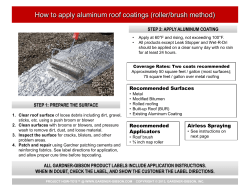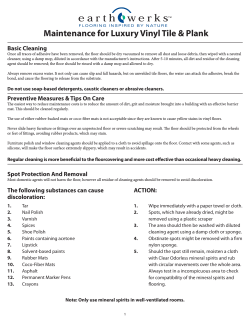
How to Green Your Sacred Space The following information has been provided by GRAHAM WHITING DESIGN Green building design, Healthy home consulting, Construction management,.LEED Accredited Professional graham@whitingdesign.ca www.whitingdesign.ca p.(519) 8972724 We are considering a major addition or new building, and want to incorporate green features into the design. Where do we start? One of the first considerations if you are considering a major project, particularly a new building, is location. Many faith communities find that the most difficult part of growing is finding the room to grow. And more often than not, the least expensive or simplest option is to select a “greenfield” site, one which lies outside established urban areas and is undeveloped. These sites tend to be anything but green in a sustainable sense, they fuel urban sprawl, demand infrastructure expansion to meet the new needs, and replace green space with paving and buildings. If you can grow in place, convert an existing building, or relocate to an urban location, you’ve made the single most important green building decision, REUSE! Now that you’ve decided to take the hard road, you’re faced with a whole host of difficult decisions. Do you have room on your property to grow? Can your building carry additional floors? What about expanded parking requirements? And how do we incorporate green design into all this? Time to engage the services of a design professional. You may find that green minded architects, planners, and engineers are few and far between, though this is rapidly changing in North America, with Ontario playing catch up. Your two best resources are word of mouth, and the internet. Talk to other groups who have had projects done in recent years, find out who they worked with, the pros and cons, etc. Most often an architect is the primary source for design and project management, they can take a leadership role and put together a team of specialists to deal with the specific challenges of your project (structural, mechanical, and electrical engineers, planners, civil consultants, etc.) For a list of all licensed architects, look to the Ontario Association of Architects website at http://www.oaa.on.ca. Look also to the LEED program (Leadership in Energy and Environmental Design), which is a new standard for green accreditation of both building projects and design professionals. The program is administered in Canada by the Canadian Green Building Council, at http://www.cagbc.org What about the construction of your green building or addition? If green minded architects are difficult to find, try finding a contractor. Again, word of mouth is your best ally, and don’t be surprised if any green project, alternative building materials, or methods inspire rolled eyes or blank stares. There are green builders out there, and again one can look to the LEED program for projects which have been certified. Remember that most green building principles are common sense ones as well. Recycling waste materials (the volume of which can be enormous on any construction site) is a simple concept, but often difficult to put into practice since most builders have fairly deeply ingrained “put it in the bin” habits. Using extra insulation in your walls is relatively easy, but most builders base their pricing on the industry standard, which is based on the minimum allowed by the building code. Engaging a contractor early in the design process will ensure that as green building principles are introduced, all parties are on board with the philosophy behind it as well as practicalities, budgets are realistic, and if there is a steep learning curve, most of it can be overcome BEFORE you start construction. Green buildings do cost a bit more, but often only in the range of a 515% premium over conventional construction. Considering that there will be energy savings, increased durability, and human comfort (thus longevity of use), these small capital investments can be paid down in savings fairly early in the lifetime of any building. What are the green alternatives to building cleaning and maintenance products? Compared to ten years ago, there are a myriad of new and effective green cleaning products on the market. Switching to some or all of these products can substantially improve the heath of your indoor environment, air quality, and send less toxic ingredients down the drain and back out into our greater environment. The primary concern with safer or more natural alternatives is that they lack the “cleaning power” of more chemically active or toxic products. This is true in some cases, conventional products which are corrosive or actively acidic are very effective at “blasting through dirt”, for very good reason… the chemicals used to create this effect are dangerous, powerful, and generally harmful to our environment. One needs to weigh the benefits of each choice, and consider whether a slightly higher application of “elbow grease” in combination with a safer product is a better choice overall. An increasing number of people, particularly children, are sensitive, allergic, or intolerant of many of the chemicals used in everyday products, to the point where many schools, businesses, and organizations have banned certain cleaning substances, including perfumes and colognes, to help these people enjoy the indoor environment without risk to their health. If you have an established supplier, ask them what green alternatives they have to the products you are currently using. Most grocery stores now have growing ‘green’ or organic sections, and specialty food and health stores almost always stock these products as well. The internet is also a great resource for locating and researching green product, here are a few links to relevant sites: Green Seal is a North American rating system with very high standards for green products: http://www.greenseal.org/certification/standards/houseoholdcleaners.cfm http://www.greenseal.org/findaproduct/index.cfm Ecologo or the Environmental Choice program is the Canadian equivalent, with lower standards but still a good measure, and rates many other products including building materials and fuels: http://www.environmentalchoice.com/English/ECP%20Home/ The following are suppliers of green cleaning and health products to the retail market: http://www.seventhgeneration.com/ http://www.nycoproducts.com/elogical.asp http://www.safesourceproducts.com/ http://www.greenhome.com/products/housekeeping/ Green Home is an American company, but their product page is a very comprehensive database of many of the green cleaning products available on today’s market. We are worried about indoor air quality. How can we improve it? Indoor air quality has become a hot topic of discussion in recent years, particularly the “Sick Building Syndrome” effect, as well as concerns about molds and other pollutants. Going smoke free has been a huge step forward in this regard, and most of the simple means of improving indoor air are as simple as that: don’t release the pollution into your air in the first place. Step One to improving indoor air quality, or IAQ, is to reduce or eliminate the use and release of pollutants. Using cleaning and maintenance products which are natural and non off gassing is a simple and effective switch to make. Another question in this series deals with specific products. When considering renovations or additions, try to use materials that are formaldehyde free and low to nonVOC. (listings of green building materials and finishes can be found in the web resource section, a good example is the ECOlogo site at http://www.environmentalchoice.com Carpets and sheet vinyl are common sources of pollution, though there are many green alternatives to these on the market. Also consider using water based and zero VOC paints, which are often the same price as normal paint products and are of equal quality. Step two, if removing sources of pollution from your air hasn’t solved your IAQ issues, is to look at existing building conditions for possible sources of contamination. This can be a very complex process, but some common sense observations can go a long way to solving problems. A primary culprit in this area is water. If water is allowed to sit in or on any organic building material (i.e. wood, paper drywall coatings, insulation) for any extended period of time, mold will grow. Many types of mold are harmless, but certain types are highly toxic and can cause mild to severe allergic reactions. If you detect mold, don’t hesitate to get expert advice and assistance in its removal, as well as the removal of moisture sources, since this can be a very dangerous health situation. Simple approaches like ensuring your gutters and downspouts are obstruction and leak free, and that the ground around the building slopes away from foundations, will keep the majority of water out of your building. Fix leaks as soon as they are detected, and do annual maintenance checks to head off any water infiltration which could lead to mold growth. Other sources of IAQ contamination can be: inadequate air filtration from your heating / cooling equipment (change your filters regularly!), inadequate fresh air supply, poor air distribution creating stale air ‘pockets’, or dust / mold contamination of ducts and mechanical equipment. Again, regular maintenance and audits of these systems by building professionals can alleviate problems, or head them off before they become an issue. Some IAQ issues may be very tenacious, and only time will alleviate the problems. Many building materials contain formaldehyde and VOC’s, and will continue to release these toxins long after they are installed. Older building materials may have stopped off gassing their original ‘load’, but in aging and breaking down can enter a new cycle of releasing dust and fiber particles. HEPA filtered vacuums and good quality air filters on furnaces can help control these problems, but ultimately, as time and money allow, materials like carpets should be replaced with nontoxic alternatives. If there are individuals in your congregation with severe allergies and or chemical sensitivities, consider creating a ‘safe room’ within your facility with a room sized air purifier and nontoxic furnishings. (A “crying room” or nursing mothers area off the main sanctuary, if you have one, is an ideal candidate). We have a large sanctuary which is only used once or twice a week, yet we pay to heat / cool it all year. How can we use it more efficiently? This is a classic problem for all assembly type buildings, the largest volume of space is often the least used. Heating and cooling these large, often high ceiling spaces uses up a substantial portion of a building’s annual energy budget. Here are a few approaches to using your sanctuary or assembly space (gymnasium, etc.) more efficiently: 1/ Use the space more often. It seems like this would go without saying, but consider the fact that if any small or large group needs to gather during weeks and evenings, there is always one large room available. Renting or loaning the space out to other community groups may not reduce your heating bills, but it will reduce the need for other similar spaces in the community, thus reducing overall global greenhouse gas emissions. If you are designing or expanding your building, consider the larger rooms as part of your programming, potentially offsetting the need for smaller meeting rooms. 2/ Separate the room into its own “zone”. A large space may often be controlled by its own separate heating or cooling units, in which case using setback thermostats and controls can substantially reduce energy use during off hours. If your sanctuary is controlled in combination with other rooms, consider making modifications to your heat / cool system to allow the larger space to be controlled separately. This can be as simple as partially closing off vent openings or valves, which forces more air or heating water into other areas of the building. Someone of course has to remember to open them up again! A mechanical contractor or engineer can advise you on methods of zoning your existing systems. 3/ Take advantage of the outdoors. If you are heating your space and have large south facing windows, have someone open the blinds on sunny winter afternoons to allow the sun to do part of the work. Conversely, lowering blinds or shades at night adds a slight insulating layer to windows, and on hot summer afternoons, keeping the solar radiation outside helps offset cooling loads. Natural ventilation can also be used to help move air in your space. For cooling, consider using or installing operable windows or vents on both the high and low points of the room, as well as opposite sides (North / South is the best orientation) to take advantage of the “stack effect”, allowing hot air to escape on hot days and drawing in cooler fresh air from shaded parts of your building, preferably on the North side. With high ceilings, the stack effect can move large volumes of air which would otherwise have to be circulated by powered mechanical systems. 4/ Install ceiling fans. This one simple renovation (if you don’t already have them) could pay for itself within months. By moving the hot air that gathers at the top of a large room around, you are not only offsetting the need for mechanical systems to move the air, but are keeping warmer air down at human and thermostat level, allowing higher comfort levels and triggering your heat system less often. A set of ceiling fans running at low speed at all times during heating season can offset substantial amounts of heating fuel use. While your electrician is up there, consider replacing your bulbs and or light fixtures with more energy efficient, cooler options, which will further reduce cooling loads in summer. Our roof is old and needs repair or replacement. What are the green alternatives? Answer: Roofs are the most essential component of your building enclosure. A properly functioning roof does the fundamental task of keeping water out of and away from all the more moisture sensitive components, thus extending the life span and heath of the whole building. The roof is an investment; putting a bit more money towards durability and a better system is definitely money well spent. The most efficient boiler in the world may save you heating dollars, but if your building rots in 10 years, what is the point? There are plenty of green roofing alternatives on the market, and each one can be broken down into three primary qualities: appearance, durability, and cost. Luckily it is relatively easy to determine the life cycle cost of various roofing systems, as the warranty on any particular product tends to correspond well to the actual life span of the roof. I am listing only sloped roofing products here, since these are the most common application for faith buildings, flat roofing and “green” or growing roofs are another subject entirely with a myriad of solutions. Those interested in green roofs could start by browsing the very informative website www.greenroofs.org Asphalt shingles: The most common and least expensive roofing material. Petroleum based, they use a nonrenewable resource, though this is now offset by greatly increased recycling programs. They are inexpensive to buy and install, and may be the only option available since the next ‘jump’ up to a better material such as steel is a big one. Look for shingles with a longer warranty (30 – 35 years are available), high recycled content (this can vary from batch to batch, check with the manufacturers based on your preferred colour and sized product), and other durability features like fiberglass or different aggregate contents. If all asphalt shingles are properly recycled, they can be a simple green alternative. Steel or Steel Tile: Increasingly popular with many faith buildings, steel has become much more accessible in cost as well, with the development of steel tile, a more versatile product that is easier to install than sheet or “standing seam” steel roofing. Steel often comes with a 50 year or longer warranty and is fully recyclable, containing a substantial recycled content in its current form as well. It does not add grit or asphalt byproducts to roof runoff, and can be painted virtually any colour. Some examples of products available include: www.hygraderoofing.com (steel tile manufacture and installation from Guelph, Ontario) http://www.vicwest.com/english/?local=east (for roll or standing seam metal roofing, as well as steel tile, siding, and other profiles) Composite Shingles: An increasing number of products have appeared over the past few years which use plastic, rubber, and cellulose recycled content in addition to other materials to create long lasting, green oriented imitation shingles or shakes. They typically fall into a price and durability range between asphalt and steel. A few examples include: Enviroshake http://www.enviroshake.com (from Chatham, Ontario) Authentic Roof Slate http://www.authenticroof.com/products.htm
© Copyright 2025





















